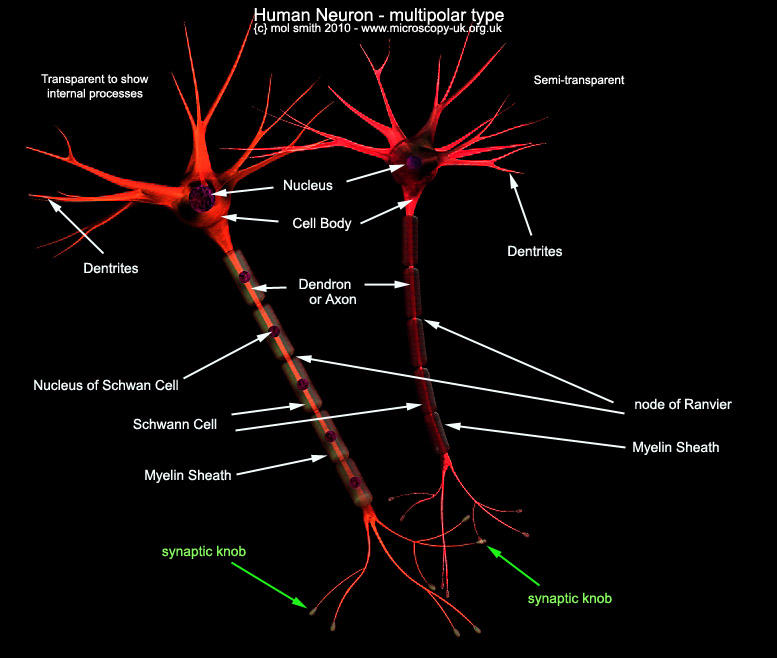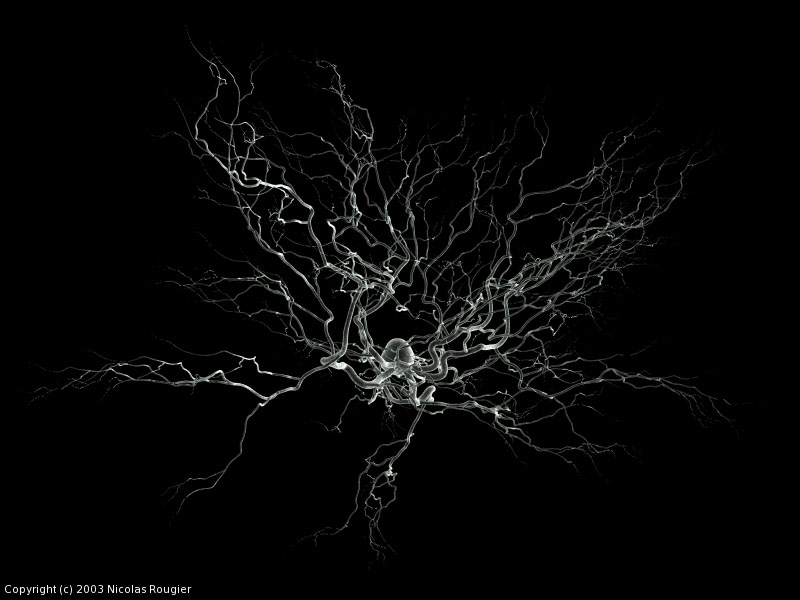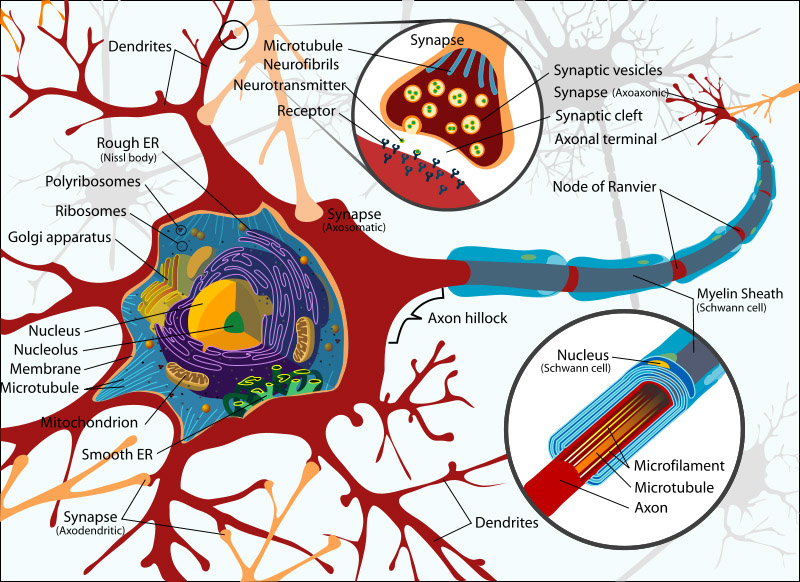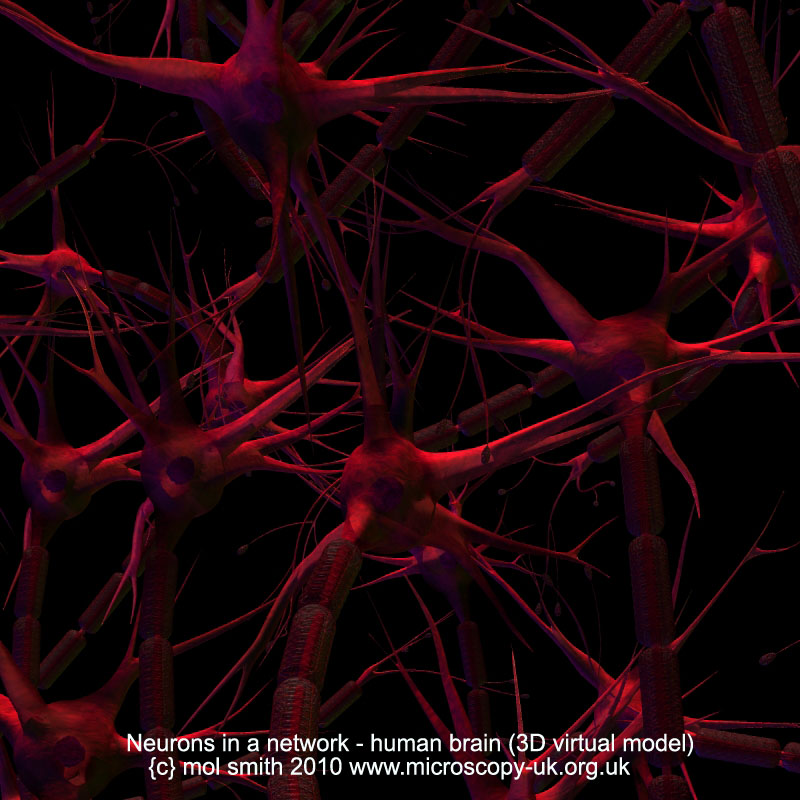|
The Human
Neuron Cell
Without doubt, the human
brain is considered the most complex structure in the explored Universe. Over 100 billion cells compacted into
a space no larger than a small melon, this organ is the seat of sophisticated awareness and a reality-modelling
system second to none. It cannot be compared to a computer, even though many analogies are incorrectly made, because
almost every single cell component is a unique processor plus memory device. Unlike computers, the brain continually
readjusts its hardware: new physical connections are constantly being made as redundant ones are broken. The magic
component in this truly outstanding achievement of evolution and nature is a cell called a Neuron.
Spelling: Neuron or Neurone?
The correct spelling in both American
English and British English can be either Neuron or Neurone, although
there is an increasingly modern tendency to consider the simpler alternative of two spellings for the same noun
as the preferred one.
Unique Cell
Neurons in the brain
(with one exception - in the hippo campus) cannot replicate themselves, and are therefore incapable of renewal,
which makes the neuron unique when compared to all other cells in the human body. Neurons form a complex web (a
network) with multi-flexible-connections achieved via tiny tentacle-like structures (dendrites), almost touching
at their tips. The microscopic gap between any two connections is called a synaptic gap, and it is across this
space, that tiny messenger chemicals travel to appropriate chemical receivers on dendrites at the far side. Processes which conduct impulses towards the main cell body are called Dendrons,
and those which conduct impulses away from the cell body are called Axons. Different types of neurons (nerve cells)
exist in the human body: , bipolar, psuedounipolar, and multipolar. These cells are future supported in the brain
by Neuroglia,
cells which are ten times more numerously packed around the neurons throughout the central nervous system. These
are thought to be involved in memory processes and their function is to encode information in the form of RNA.
I have a used a single 3D model of a Neuron to create an artist's view of a section of a Neural Network composed
of brain cells. This movie below represents a static section of the human brain, minus supporting tissues, chemicals,
and blood vessels.
Now, let us take a closer
look at a single Neuron. I have used a virtual 3D model to produce two cells below. They are the same cell but
I have made one of them more transparent so you can look at the hidden processes inside.

You might wish to compare my model with the SEM
image of a similar Neuron below, and then see the detailed diagram beneath it. Both these images are from Wiki
and are used here under the collective commons licence. Please refer to wiki for reuse permissions.

The SEM image of a Neuron
is produced here (above) under the Creative Commons Licence and is located at Wiki.
Please visit http://commons.wikimedia.org/wiki/File:Neuron-SEM-2.png for reuse permissions

This image used from http://en.wikipedia.org/wiki/File:Complete_neuron_cell_diagram_en.svg
Please follow link
for further permissions of use.
I think one of the true miracles
of the human brain is the fact that the Neuron uses both electrical and chemical processes to facilitate communication
between cells. This ultimately produces human thought.
Information Processing
- The Synapses
My movie below (made from using virtual
3D models) clearly shows how one Neuron communicates with another. An electrical signal travels along the Axon
or Dendron to the Dendrites where chemical messaging molecules 'swim' across the synaptic gap to appropriate receiving
pores on the other cell. The reception of the transmitter chemical triggers an electrical signal in the interconnecting
cell. Some forms of mental ill health - notably, depressive illnesses - are thought to be caused by an imbalance
or reduced quantity of one or more chemical transmitters (e.g. dopamine, serotonin).
For a higher quality
movie (800x800) - please click here.
Neurons also exist throughout the human body and
transmit signals to and from the brain at up to 200 mph. The axon is a long extension of a nerve cell, and takes
information away from the cell body {A&D}.
Bundles of these axons are what we commonly term 'nerves' when located away from the brain (Central Nervous System
- CNS). Dendrites bring information to
the cell body
{B & C}. The Axon is insulated (like a copper stranded wire is
with plastic) by a Myelin coating, except for periodic breaks called nodes of Ranvier, increasing transmission
speed along the Axon. The Myelin is manufactured by Schwann's cells, and consists of 70-80% lipids (fat) and 20-30%
protein. The cell body (soma) contains the neuron's nucleus (with DNA and typical nuclear organelles).
A typical neuron has about 1,000 to 10,000 synapses (that is, it communicates with 1,000-10,000 other neurons,
muscle cells, glands, etc.). The complexity of such a network confounds our attempts to fully comprehend the staggering
complexity and sheer sophistication of the human brain.
This exquisite schematic diagram below (Public
Domain from Wiki) reiterates the
process very clearly.

A public domain image
from Wiki please see
http://en.wikipedia.org/wiki/File:Chemical_synapse_schema_cropped.jpg
for reuse permissions
Before leaving our brief look at the Neuron, I would like to inspire you with another image and
some personal observations - not so scientific, but interesting theoretically none-the-less. Here is a conceptualised
network of neurons in the human brain. We may well think of the brain (mind) a bit like a Turin Machine (computer),
where information comes in through a variety of physical senses, is mapped and compared with previous information,
and then used to activate an external response (run, shout,) or make a decision, or even just determine another
perspective about our external world. Nothing comes out which isn't already 'put-in' in the first place. But this
idea may not be entirely true! Roger Penrose, a distinguished UK mathematician and associate of Stephen Hawking,
believes micro (nano) organelles may exist in the brain which allow information in a general sense to enter the
system from the quantum world of sub-atomic particles and energy packets. This was put forward in one of his book's
- The Emperor's New Mind
and I would recommend reading this work if you believe the mind/brain is no more than a very sophisticated computer.

Disease
Diseases of the Brain or CNS are explored in the Anatomy
of the Brain. However, one disease which typically targets the neurons of the human brain is Motor Neuron Disease
*wiki
Motor Neuron Disease is a set of conditions which
affect motor neurons *wiki and normally mainfest symptoms in people aged 50 to 70
years. The outcome is progressive muscle wasting, weakness, muscle fasciculations, spasticity or stiffness in the
arms and legs, and overactive tendon reflexes. Patients may have slurred speech or other less common symptoms.
Every muscle group in the body requires both upper and lower motor neurons to function, therefore any malfunction
in the neurons controlling any muscle group, will manifest difficulties in those areas and often will culminate
in progressive loss of function.
Prognosis
Most cases progress quite quickly with patients declining
rapidly over several months and suffering increasing motor disjunction at the disease spreads to other areas of
the brain. Motor Neuron Disease is normally fatal within 2–5 years with about half of patients dying within just
over the first year from diagnosis. Those who do not succumb within the first year to 15 months, may survive up
to 10 years with 1 in 5 patients surviving for 5 years, and 1 in 10 patients surviving 10 years.
|